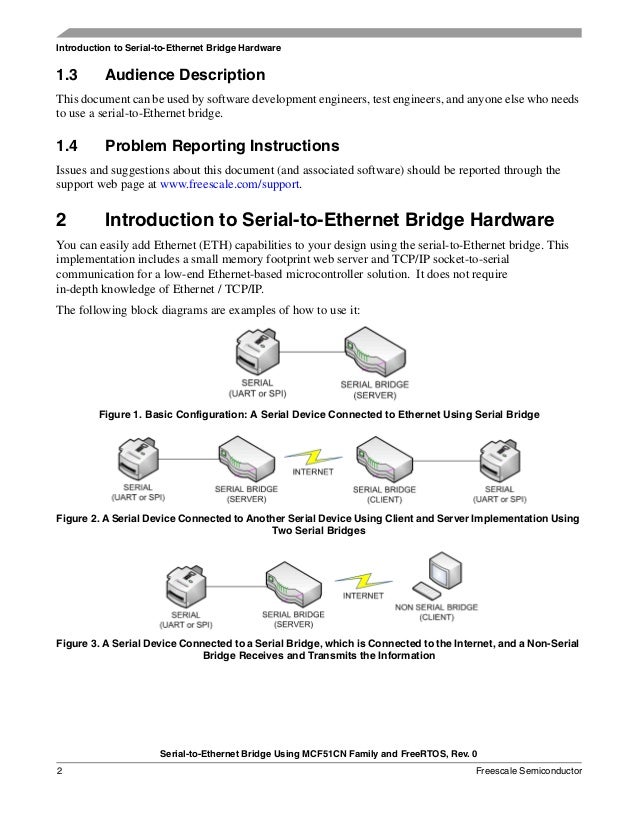

- Serial to tcp bridge install#
- Serial to tcp bridge serial#
- Serial to tcp bridge drivers#
- Serial to tcp bridge software#
The "Virtual COM Port" tricks your PC into thinking that the serial port on the Serial Device Server (or TCP-Com) is actually a RS232 port installed locally on your PC. To make everything work transparently with existing software, you would also need the ability to create a “Virtual COM Port" on every PC in the network that needs to communicate with each RS232 device. The IP address of the PC where TCP-Com is running is used for all of the exposed serial ports on that PC and you configure TCP-Com to feed data from each serial port through a different TCP/IP port. You still connect the instrument to a RS232 serial port on the PC, however the PCs network connection is used to share the serial ports on that PC with other workstations in the network.
Serial to tcp bridge software#
In other words, it does the same job as a hardware based Serial Device Server except that it is a software program that you run on a PC. TCP-Com is a program that you run on a PC to expose the serial ports on that PC to the network. The serial device server becomes just another node on the network. This means that each device server would need to be configured with a unique IP address just like each PC connected to a TCP/IP network has its own unique IP address. In most cases, the TCP/IP network protocol is used to pass data across the network. The hardware device servers must be connected to a hub or switch using standard network cables. It is basically a small computer that establishes a network connection and then feeds any data that it receives through the RS232 port out over the network connection through a TCP/IP port and vice versa. A hardware based Serial Device Server is a small box that has a RS232 serial port on one side and an Ethernet connector on the other. The way that it works is that you use your existing network instead of running RS232 serial cables and then connect the RS232 serial instruments directly to the network using an appropriate (hardware or software) converter. TCP-Com essentially allows you to use a PC as a Serial Device Server. You could use either a small hardware device called a “Serial Device Server” or you could use our TCP-Com software to expose the serial ports on a PC to a TCP/IP network. You would then be able to use an existing Ethernet network as the backbone for connecting all the RS232 instruments to all the PCs in a network or even across the Internet. The trick is to use a RS232 to TCP/IP converter (like TCP-Com or a hardware based “Serial Device Server”) to convert the RS232 serial connection to a TCP/IP network connection. If the RS232 standard were to be improved upon, it would allow multiple connections through a single cable, there would be no restriction on the cable length and it would remain 100% compatible with all existing RS232 communications software.įortunately there is a very simple way to accomplish all of the above improvements (and more) using inexpensive hardware or software ( TCP-Com).
Serial to tcp bridge install#
If you want to connect multiple devices to a single PC, you must install multiple RS232 ports on the PC. You must also run a separate cable to a unique RS232 port on a PC for each instrument that you need to communicate with.


The problem with RS232 communications is that it requires a point-to-point cable connection that is limited in the distance that you can run a cable.
Serial to tcp bridge drivers#
Many newer devices that connect to a PC's USB ports are shipped with drivers that emulate a RS232 port so that they remain compatible with RS232 communication software. Because of the flexibility and the ubiquity of the RS232 standard, it is likely to continue being relevant well into the future. There are also hundreds of software applications available for communicating with instruments through RS232 connections. Almost all computers are equipped with at least one RS232 port with inexpensive add-on adapters widely available. The RS232 protocol has been around for many years and is well established with a number of inexpensive hardware and software solutions available for it.

Most modern electronic instruments including measuring tools and laboratory instruments (balances, electrochemistry meters, spectrometers, spectrophotometers, etc.) interface to a computer using a standard RS232 serial cable connection. Questions? Call us at: (800) 722-6004 or (215) 496-0222Ĭonnecting to a RS232 Serial Device over a TCP/IP Network Details how a RS232 (serial) device can be accessed over a TCP/IP network using either a Serial Device Server or our TCP-Com software.


 0 kommentar(er)
0 kommentar(er)
